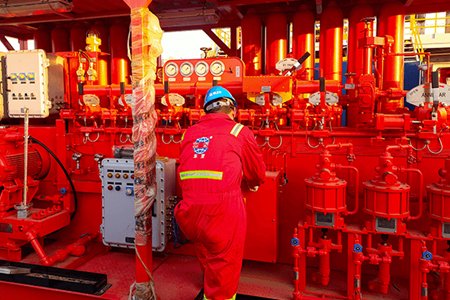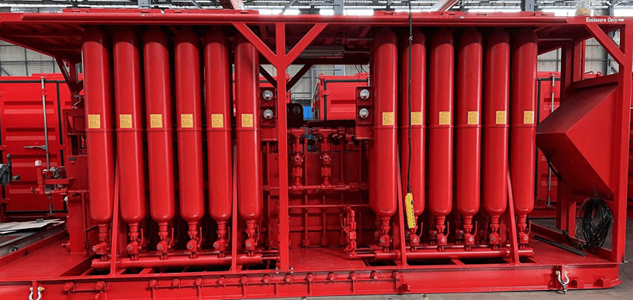In the unforgiving realm of oil and gas drilling, safety reigns supreme. The extraction of hydrocarbons from deep within the Earth's crust demands meticulous planning, cutting-edge technology, and unwavering adherence to stringent safety protocols. Among the myriad safeguards employed to mitigate potential disasters, blowout preventer (BOP) equipment stands as a frontline defense against catastrophic blowouts – the nightmare scenario that can wreak havoc on human lives, the environment, and the financial viability of drilling operations.
Blowout preventer equipment represents the last line of defense, engineered to exert control over the unruly forces lurking beneath the surface. These critical devices are designed to seal off a wellbore in the event of an unexpected surge in pressure, effectively preventing the uncontrolled release of oil or gas – a phenomenon commonly referred to as a blowout. However, the efficacy of blowout preventer equipment is contingent upon a myriad of factors, each bearing significant weight in the decision-making process of selecting the appropriate BOP configuration.

Before delving into the intricate dance of selecting the right blowout preventer equipment, it is imperative to grasp the fundamental principles underlying its design and functionality. Blowout preventers come in a variety of types and configurations, each tailored to address specific challenges encountered during drilling operations.
At the forefront of blowout preventer classification are ram-type preventers and annular preventers. Ram-type preventers, as the name suggests, employ hydraulic rams to swiftly close off the wellbore by means of a mechanical barrier. These robust devices are particularly effective in situations necessitating rapid intervention to staunch the flow of fluids from the well.
On the other hand, annular preventers – often referred to as "packing element" preventers – create a seal by exerting radial pressure on a flexible, doughnut-shaped element encircling the drill pipe. This method offers a more versatile solution, capable of accommodating variations in pipe diameter and sealing irregular wellbore geometries.
Well Depth and Pressure Ratings
The depth and pressure characteristics of the well serve as primary determinants in selecting the appropriate blowout preventer equipment. Deepwater drilling operations, characterized by elevated pressure environments and formidable geological formations, demand BOPs endowed with robust pressure ratings capable of withstanding the immense forces exerted by the subterranean reservoirs.
The choice of blowout preventer equipment must be meticulously aligned with the anticipated well conditions to ensure optimal performance and safety throughout the duration of drilling operations. Failure to account for these critical parameters can expose drilling crews to grave risks, jeopardizing both personnel safety and the integrity of the drilling infrastructure.
Compatibility with Drilling Equipment
In the intricate ballet of drilling operations, seamless coordination between blowout preventer equipment and ancillary drilling components is paramount to operational success. Compatibility issues between BOPs and other essential equipment, such as the drill pipe, casing, and wellhead, can disrupt workflow, compromise safety, and incur substantial financial losses.
Operators must meticulously evaluate the compatibility of blowout preventer equipment with existing drilling infrastructure to mitigate the risk of operational inefficiencies and equipment malfunction. Ensuring harmonious integration between BOPs and associated components fosters operational fluidity, minimizes downtime, and bolsters safety protocols.
Regulatory Compliance
The oil and gas industry operates within a regulatory framework governed by stringent guidelines and standards established to safeguard human lives, protect the environment, and uphold industry integrity. Regulatory bodies such as the American Petroleum Institute (API), the International Organization for Standardization (ISO), and government agencies impose rigorous requirements governing the design, manufacturing, and operation of blowout preventer equipment.
Operators must prioritize compliance with these regulatory mandates to ensure equipment reliability, mitigate operational risks, and safeguard against potential legal repercussions. Investing in blowout preventer equipment certified to meet or exceed industry standards instills confidence in the efficacy and safety of drilling operations, assuring stakeholders of the operator's commitment to operational excellence and environmental stewardship.
Reliability and Maintenance
The reliability of blowout preventer equipment stands as a cornerstone of operational integrity, underpinning the safety and efficiency of drilling operations. Any lapse in BOP functionality, whether due to equipment failure or human error, can precipitate catastrophic consequences, including well blowouts, environmental contamination, and loss of life.
Operators must conduct comprehensive assessments of blowout preventer equipment, evaluating factors such as performance track record, manufacturer reputation, and availability of spare parts and technical support. Proactive maintenance strategies, encompassing routine inspections, preventative maintenance measures, and contingency planning, are essential to preserving the functionality and longevity of BOPs throughout their operational lifecycle.

In the dynamic and unforgiving realm of oil and gas exploration, selecting the right blowout preventer equipment is a decision of paramount importance. By meticulously considering factors such as well depth and pressure ratings, compatibility with drilling equipment, regulatory compliance, and reliability and maintenance considerations, operators can navigate the complexities of BOP selection with confidence and precision.
Investing in high-quality blowout preventer equipment that aligns with industry standards and operational exigencies is indispensable for fortifying safety protocols, safeguarding personnel, and upholding environmental stewardship in drilling operations. As the guardians of operational integrity, operators must remain vigilant in their commitment to selecting and maintaining blowout preventer equipment that embodies the highest standards of reliability, safety, and performance. In doing so, they ensure the resilience and sustainability of drilling operations in the face of myriad challenges and uncertainties inherent to the oil and gas industry.
By continuing to use the site you agree to our privacy policy Terms and Conditions.